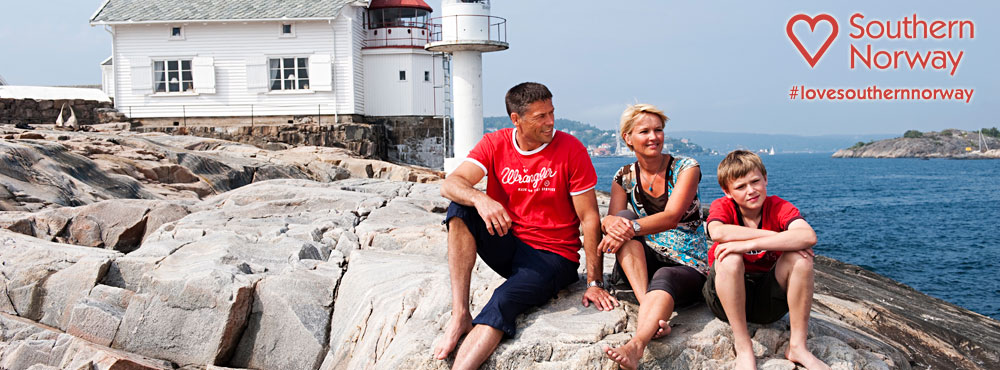Hægebostad is an area just outside of Lyngdal in Southern Norway. Its history dates back well before the Viking times where ancient rituals were practised around groups of large stones at Tingvatn. The area is an archaeologist’s dream, where ancient items have been found over the years.
%2B(2).jpg) |
| Hægebostad Photo: Lyngdal Tourist Office |
Snartemo Sword
One such item is the ancient Snartemo sword. The sword was found on a farm in 1933 by Richard and Olav Kjellingland when they were about to prepare the land for farming. A tomb was located under a large stone slab dating back to the early 500's. Inside the slab was a sword that was to be called the “Ancient Snartemo sword.” There were also other items in the tomb including metals, a weapon set, rare fabrics and bear claws.
 |
| Large sword monument at Snartemo. Photo Adam Read |
This amazing discovery resulted in a press and media frenzy across the world and has been hailed as the "The loveliest migration time grave find to this day was dug up on Norwegian soil."
Because the sword had been buried in this tomb for thousands of years, it had decayed over time and was in three pieces. The handle of the sword was adorned with gold ornaments of human figures and fantasy creatures and the buckle was decorated with animal heads.
The sword was adorned with geometric patterns and swastikas.
German interest
Interest in Nordic archeology was strong in Germany pre-war and its scientists were among the leaders in the field. This resulted in a close relationship between the German and Norwegian archaeologists.
In fact, information about the sword and its discovery was translated into German in 1935 and two years later, a Norwegian archaeologist named Bjørn Houge traveled to Germany for a lecture on the sword.
In 1936 the International Congress of prehistoric and historical research was held in Oslo. There was a special exhibition with Snartemo discovery as the main attraction. Several leading German archaeologists attended and among them was Herbert Jankuhn, who came to play a central role in the drama a few years would unfold in Norway. He was Himmler’s right hand man for culture and archaeology. In this role he hunted numerous artefacts from German occupied countries including of course, the Snartemo Sword.
War
Then war broke out between Germany and most of Europe and Norway was occupied from 1940 to 1945.
 |
| Herbert Jankuhn at a project. Photo: Archive of Rijksmuseum van Oudheden, Leiden |
The Vikings were of course seen as being successful warriors and so the Germans were fascinated or even desperate to get their hands on anything found from those times.
Some Norwegian archaeologists foresaw a problem with this before the German invasion of Norway in 1940 and so wanted to protect these precious artefacts. As a result, the sword was hidden in a vault at the Bank of Fagernes which is a little remote town in the middle of Norway. There were very few who knew of its location. Two replicas were also made by the Germans from photos, drawings and writings. One of these was presented to a Norwegian Nazi sympathiser - Vidkun Quisling, during a ceremony in 1943. The occupiers were unable to find the original, so it was a bitter sweet smile because he knew it was a copy and that they could not find the original.
 |
| Vidkun Quisling with Hitler photo: Riksarkivet |
One year after the end of the German occupation during World War 2, the sword was returned to the Museum of Cultural History where the sword still is to this day.
Later in the 1990’s a company in Lyngdal was given permission to make four copies of the sword. One was given to the Tingvatn fornminnepark og besokssenter, one was given to the King of Norway as a gift when he visited the region, one was also given to the Museum of Cultural History in Oslo and the other is believed to be kept by the maker.
 |
| Copy of sword at Tingvatn. Photo Adam Read |
 |
| Copy of sword knitted emblem. Photo Tingvatn fornminnepark og besokssenter |
Unfortunately nothing is known of the man that owned the sword, but he was believed to be a man of importance, as the sword and other items that was found with the sword were very valuable in the 500’s.
The gold and different metals used on the sword are said to have come from various parts of Europe but it is believed that it may have been made locally in the Hægebostad area.
Tingvatn fornminnepark og besokssenter
Visitors can learn about the sword's history at the "Tingvatn fornminnepark og besokssenter" in Hægebostad and see a full sized replica. There is a very detailed article about the sword and Germany's obsession with finding it can also be found at the museum.
 |
| Explore history at the Tingvatn fornminnepark og besøkssenter. Photo: Adam Read |
Tingvatn is approximately a one hour drive from Kristiansand. There are direct flights to Kristiansand from Amsterdam and Copenhagen as well as domestic connections within Norway.
Tingvatn fornminnepark og besokssenter
Address: Tingvatn, 4595 Tingvatn
Amenities: General facilities: parking, toilet
www.tingvatn.no
post@tingvatn.no
(Sword is located at 4590 Snartemo).
Amenities: General facilities: parking, toilet
www.tingvatn.no
post@tingvatn.no
(Sword is located at 4590 Snartemo).
 |
| The Red symbol is where Tingvatn is located. |








